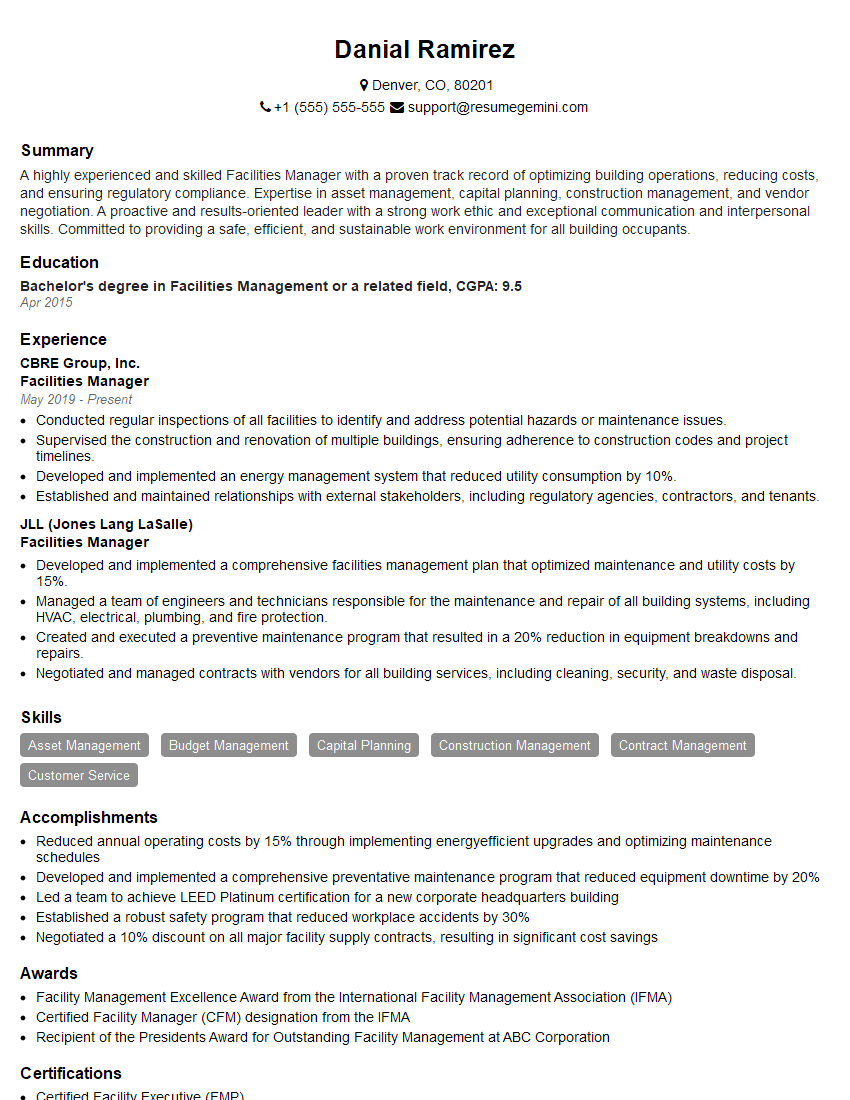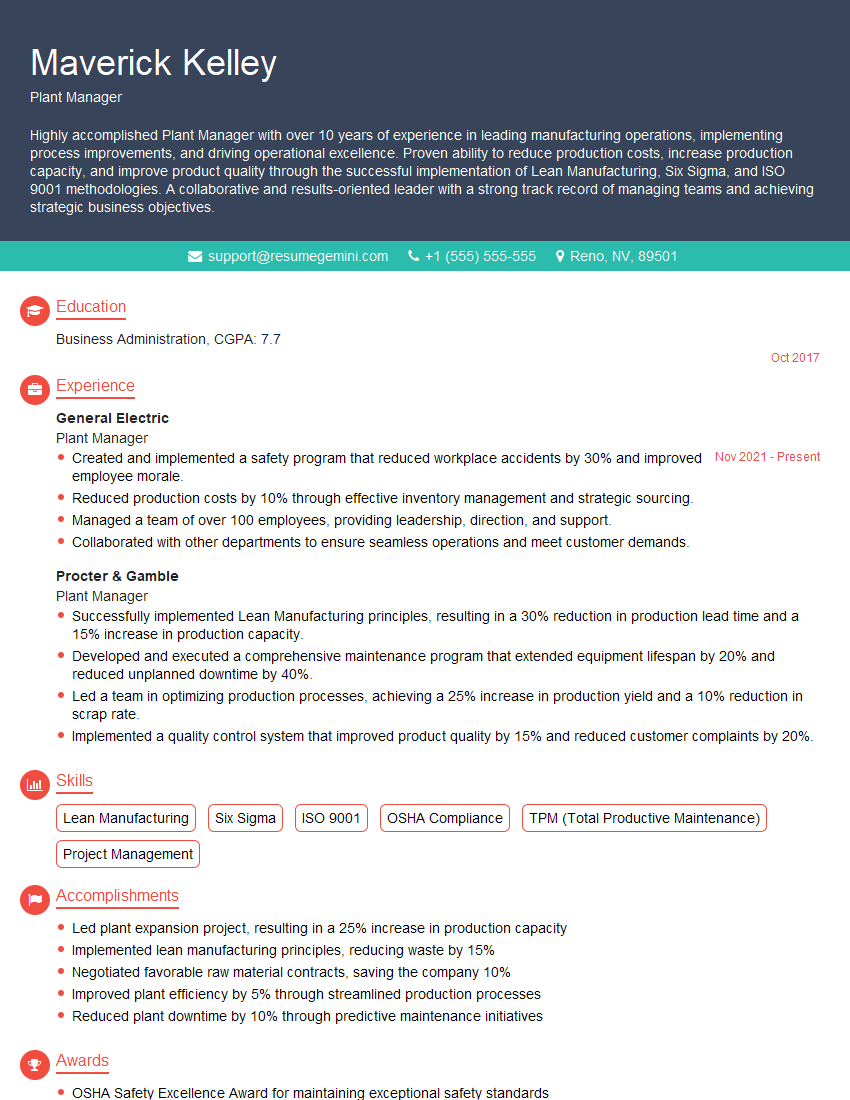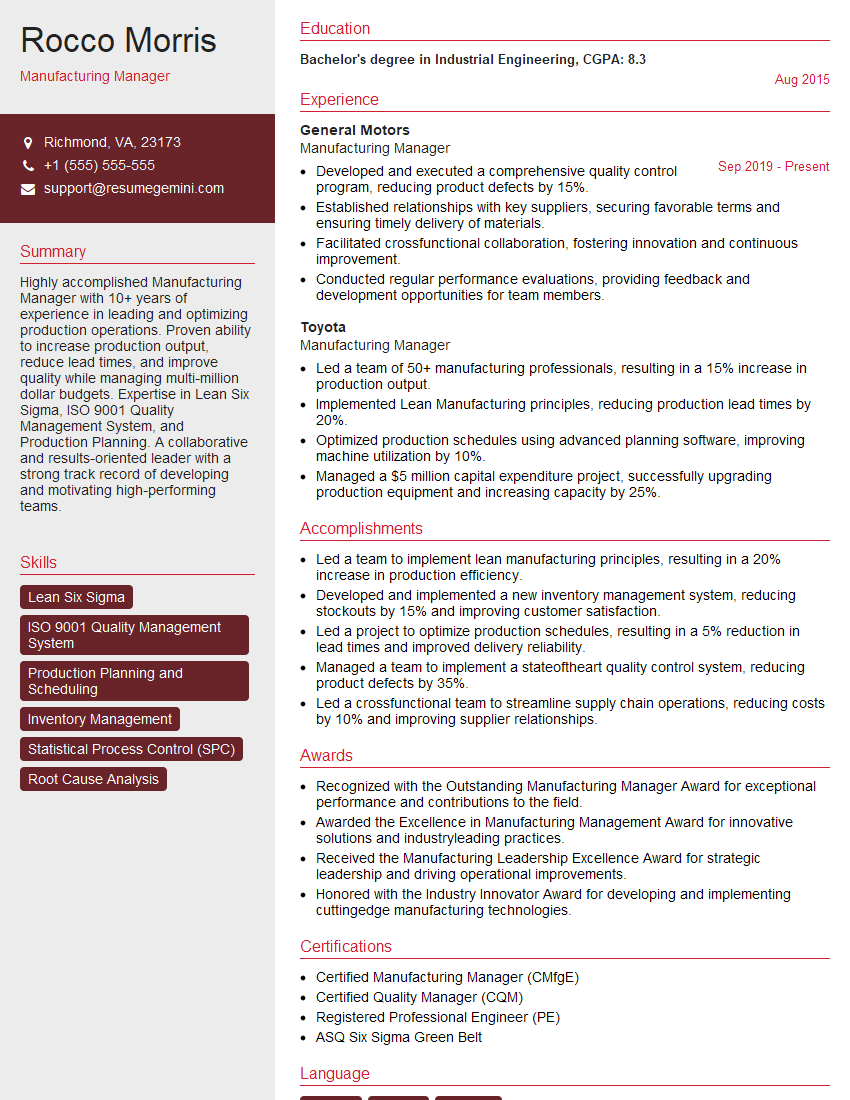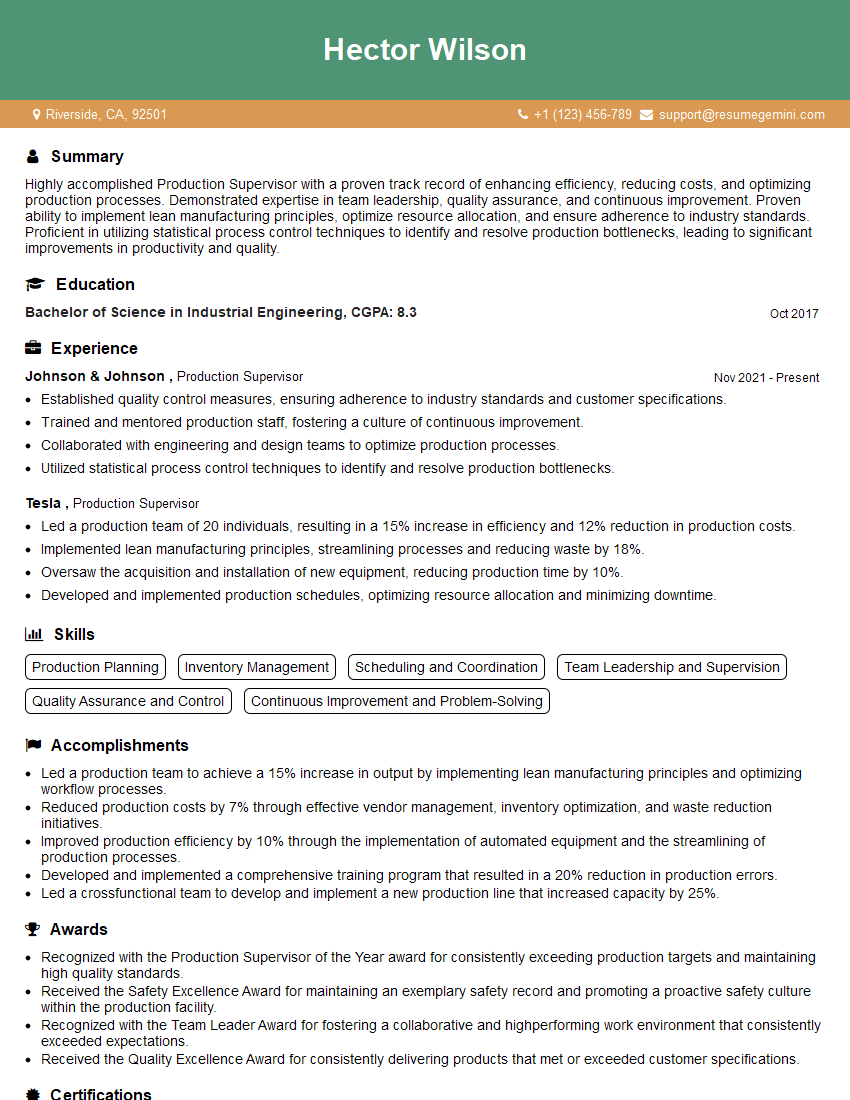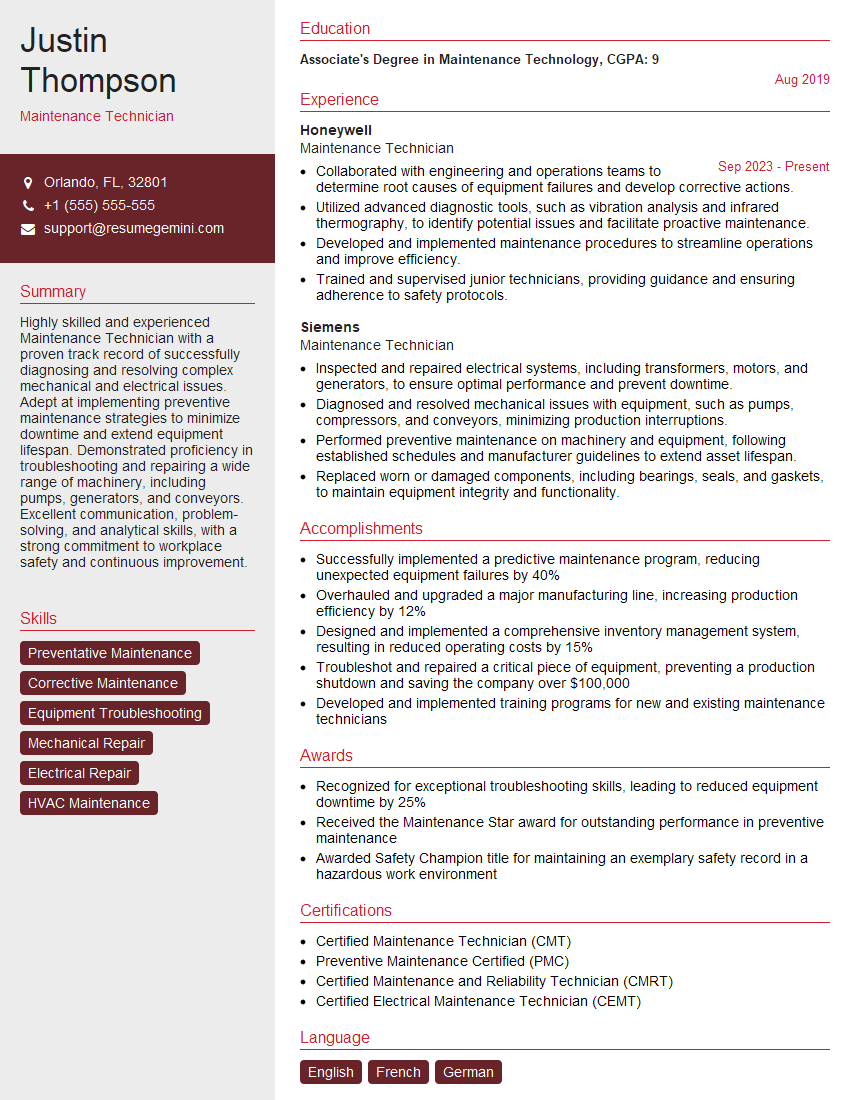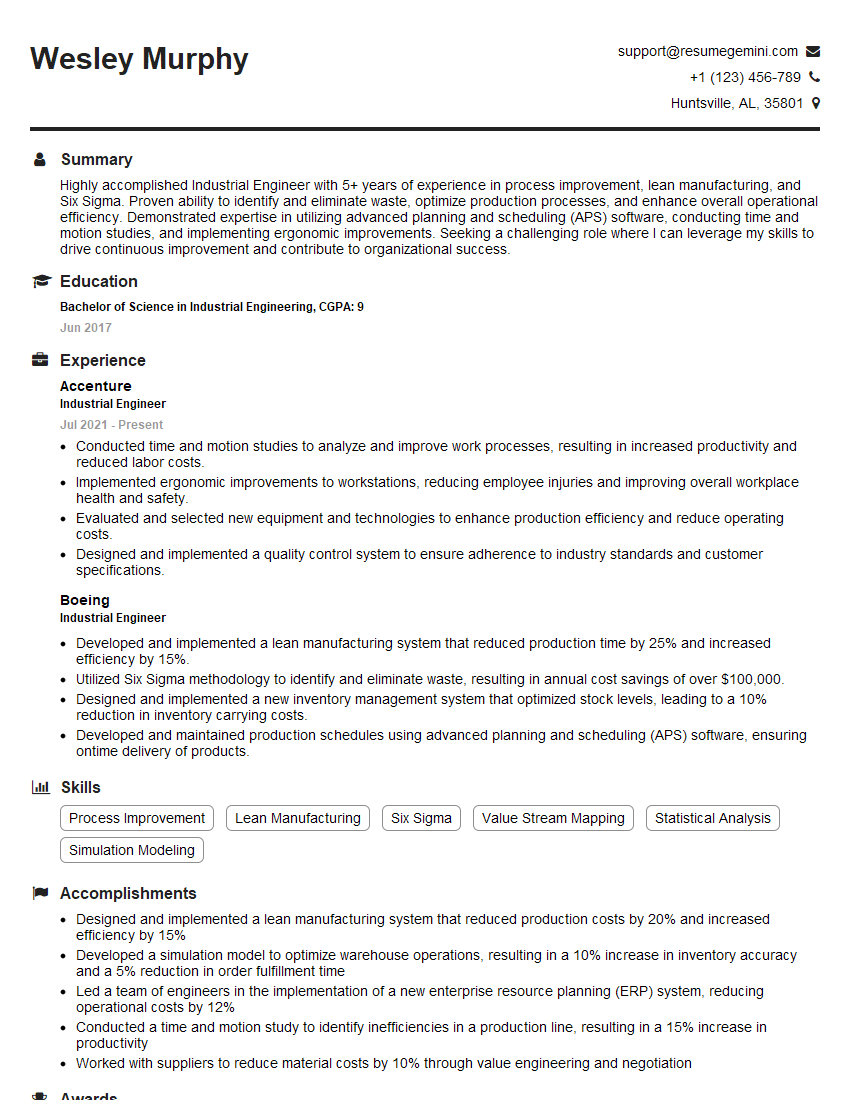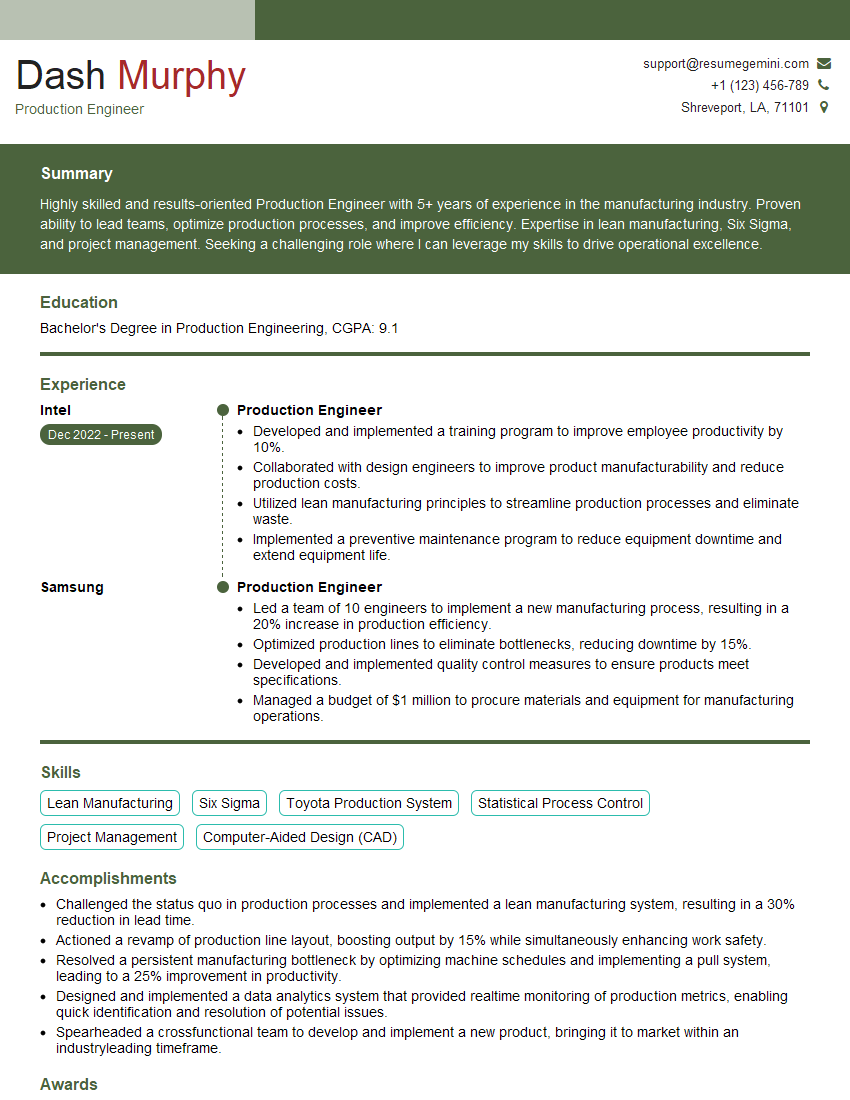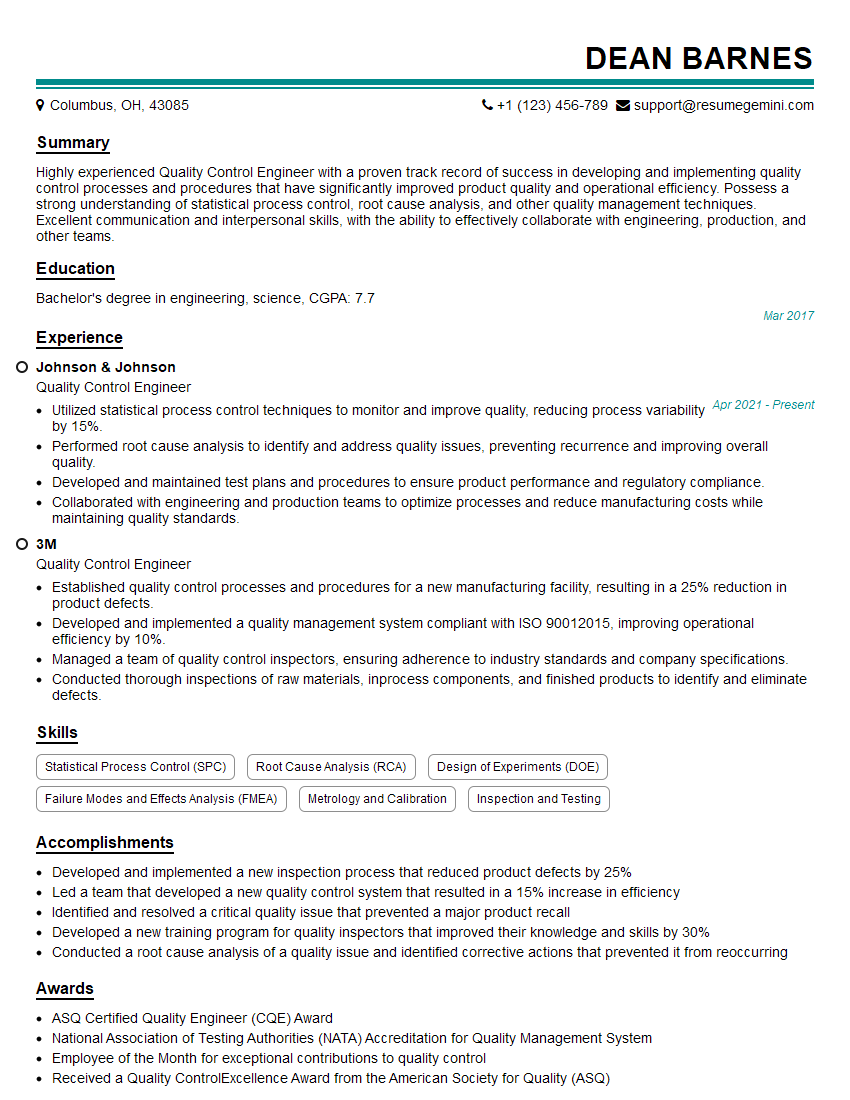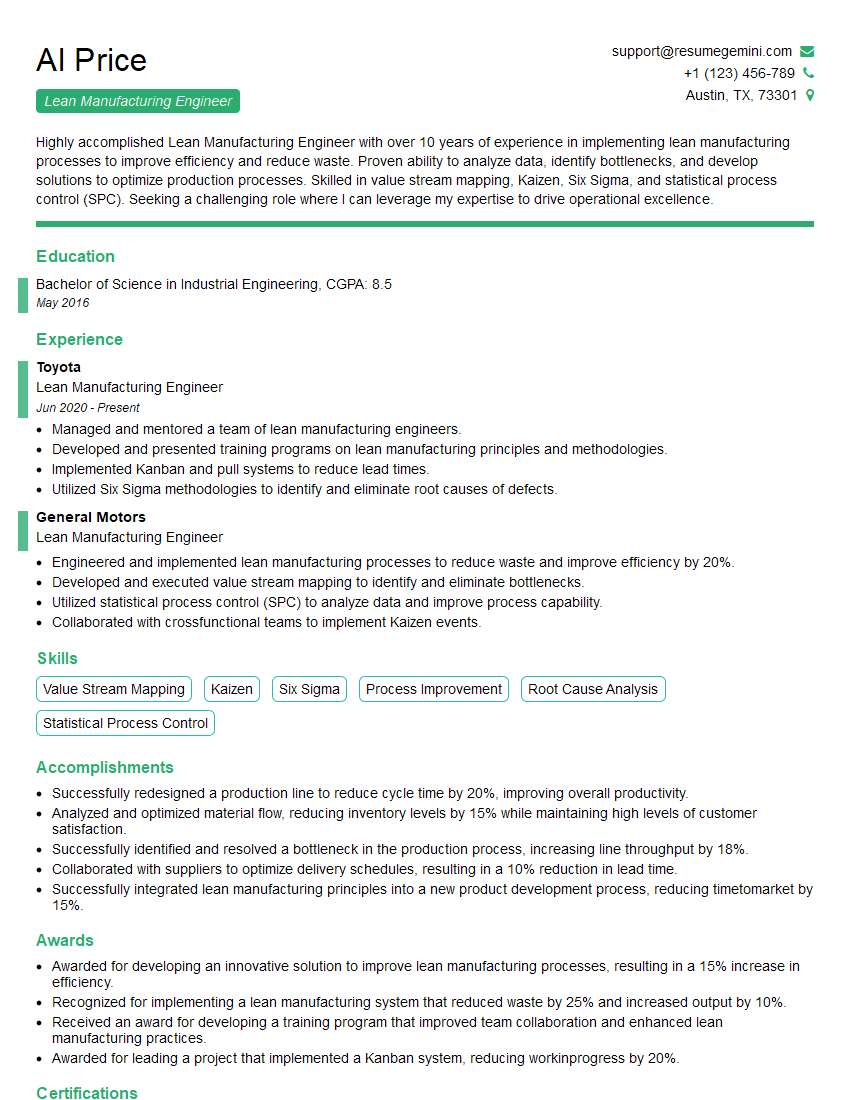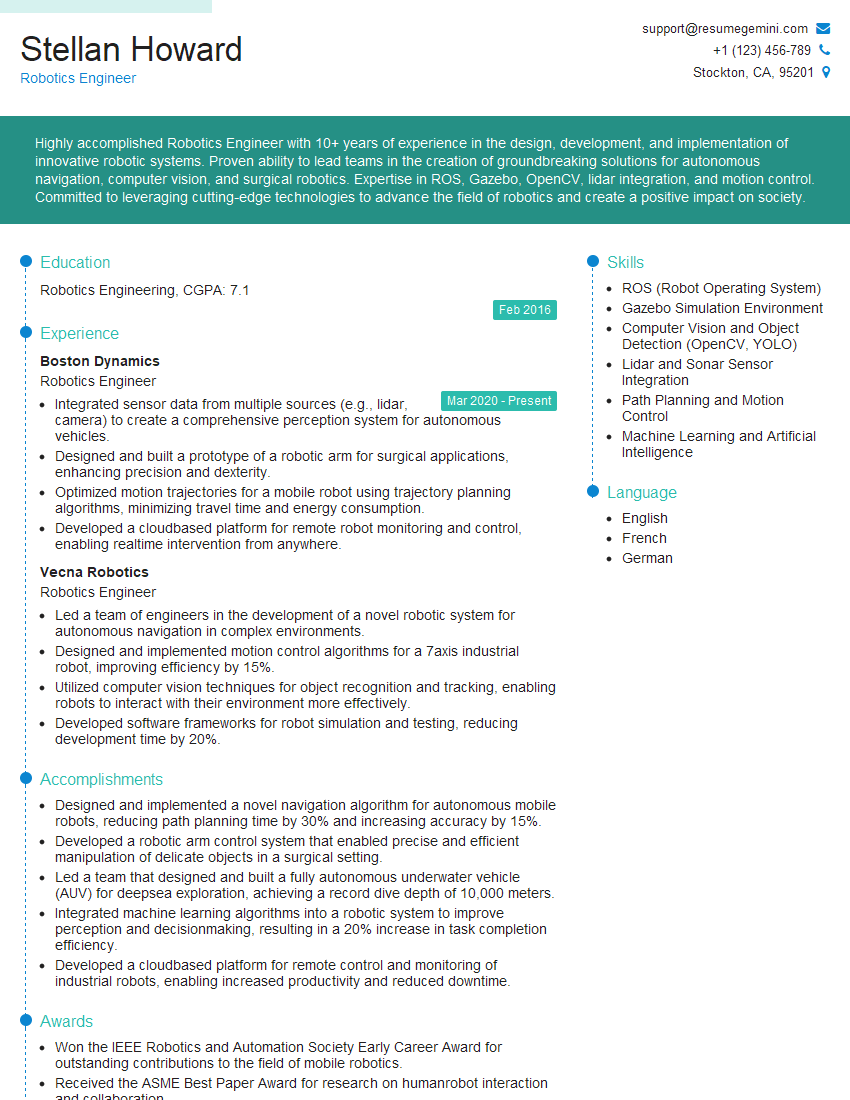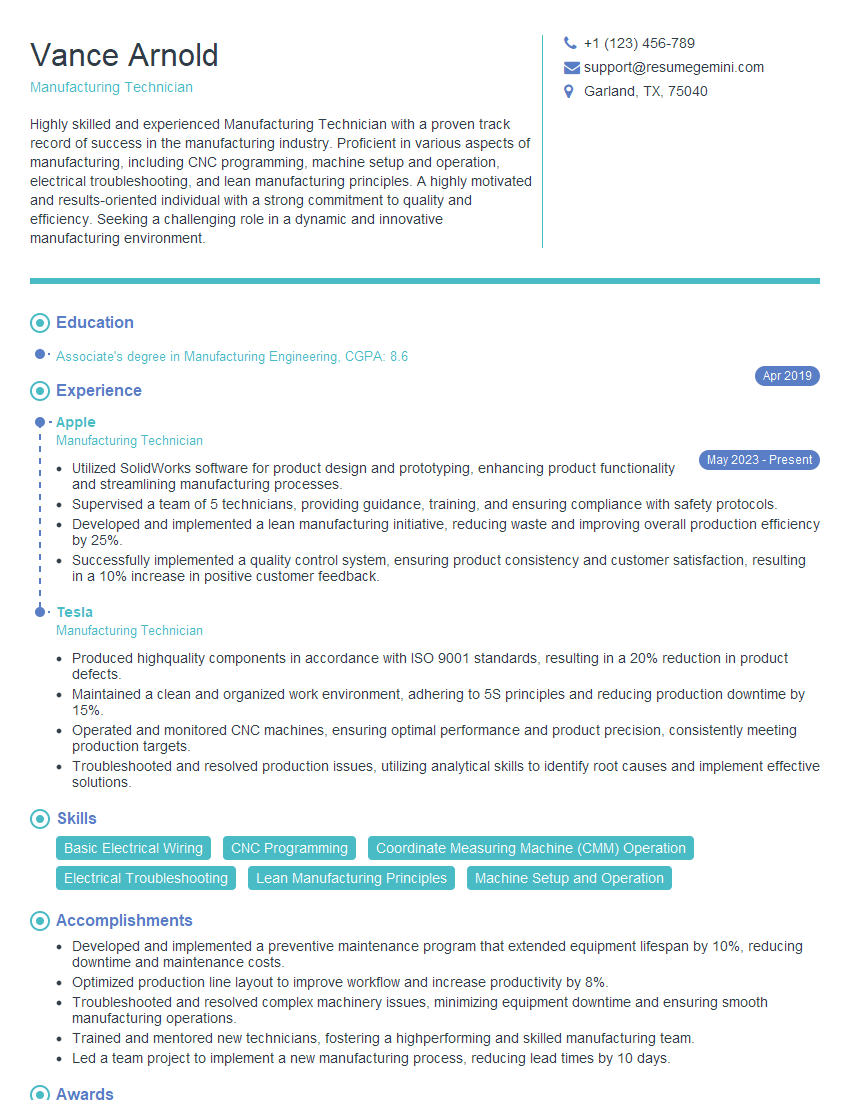The thought of an interview can be nerve-wracking, but the right preparation can make all the difference. Explore this comprehensive guide to Understanding of Manufacturing Processes and Equipment interview questions and gain the confidence you need to showcase your abilities and secure the role.
Questions Asked in Understanding of Manufacturing Processes and Equipment Interview
Q 1. Describe your experience with different manufacturing processes (e.g., injection molding, machining, stamping).
My experience spans a wide range of manufacturing processes, encompassing injection molding, machining, and stamping. Let’s start with injection molding. I’ve worked extensively with various thermoplastic and thermoset materials, overseeing the entire process from mold design and material selection to machine parameter optimization and quality control. A particular project involved optimizing the injection parameters for a complex automotive part, reducing cycle time by 15% and improving dimensional accuracy significantly. In machining, I’m proficient in CNC milling and turning, using various cutting tools and programming languages like G-code to fabricate precision parts. I’ve managed projects involving both single-part production and high-volume manufacturing runs. For example, I implemented a new toolpath strategy that reduced material waste by 20% in a high-precision aerospace component machining process. Lastly, with stamping, I have hands-on experience with different press types and die designs, working on projects ranging from simple blanking operations to complex progressive die stamping. This included troubleshooting a production bottleneck in a sheet metal stamping line, identifying and resolving a tooling issue that increased production efficiency by 30%.
Q 2. Explain the concept of Lean Manufacturing and its application in a manufacturing environment.
Lean manufacturing is a systematic approach to identifying and eliminating waste in manufacturing processes. Think of it like decluttering your home – you remove anything unnecessary to maximize space and efficiency. The core principle is to focus on value-added activities from the customer’s perspective. This involves minimizing seven types of waste: Transportation, Inventory, Motion, Waiting, Overproduction, Over-processing, and Defects (often remembered by the acronym TIMWOOD). In a manufacturing environment, Lean principles are applied through various tools such as Value Stream Mapping (visualizing the entire process flow to identify bottlenecks), 5S (Sort, Set in Order, Shine, Standardize, Sustain – organizing the workplace for efficiency), Kanban (a visual signaling system for managing inventory), and Kaizen (continuous improvement). For instance, in a previous role, we implemented a Kanban system for managing raw material flow, significantly reducing lead times and inventory holding costs. We also used Value Stream Mapping to identify and eliminate a significant bottleneck in the assembly process, resulting in a 20% increase in throughput.
Q 3. What are the key performance indicators (KPIs) you would monitor in a manufacturing setting?
The key performance indicators (KPIs) I monitor in a manufacturing setting depend on the specific goals and objectives, but generally include: Overall Equipment Effectiveness (OEE), measuring the percentage of time a machine is producing good parts; Production Rate/Throughput, the number of units produced per unit of time; Defect Rate/Yield, the percentage of defective products; Lead Time, the time it takes to complete a product from order to delivery; Inventory Turnover, how efficiently inventory is managed; Cost per Unit, the cost to produce a single unit; and Safety Incidents, focusing on maintaining a safe working environment. Regular monitoring and analysis of these KPIs allow for proactive identification of areas needing improvement and data-driven decision-making.
Q 4. How do you troubleshoot equipment malfunctions and downtime?
Troubleshooting equipment malfunctions and downtime requires a systematic approach. I typically begin with a thorough inspection to identify the root cause, which may involve checking for mechanical issues, electrical faults, or software errors. I use diagnostic tools such as multimeters, oscilloscopes, and PLC programming software to pinpoint the problem. Once identified, I prioritize the repair based on the severity of the issue and its impact on production. A typical process involves: 1. Identifying the problem (Is it a sensor failure, a hydraulic leak, or a software glitch?), 2. Isolating the cause (Using diagnostic tools and systematically checking components), 3. Implementing the solution (Replacing faulty parts, making electrical repairs, or updating software), 4. Verifying the fix (Testing the equipment and ensuring it operates correctly), and 5. Documenting the issue and solution for future reference and preventative maintenance planning. For example, I once resolved a recurring downtime issue in an injection molding machine by identifying a faulty pressure sensor and promptly replacing it, preventing further production losses.
Q 5. Describe your experience with preventative maintenance programs.
My experience with preventative maintenance programs emphasizes a proactive approach to equipment upkeep. This involves establishing a schedule for regular inspections, lubrication, cleaning, and component replacements based on manufacturer recommendations and historical data. This prevents unexpected downtime and extends the lifespan of equipment. I’ve implemented and managed preventative maintenance programs utilizing computerized maintenance management systems (CMMS) to track maintenance activities, schedule tasks, and manage spare parts inventory. A successful example involved implementing a predictive maintenance program using vibration sensors on critical machinery. By analyzing vibration data, we were able to predict potential failures before they occurred, significantly reducing downtime and maintenance costs.
Q 6. What quality control measures are you familiar with?
I am familiar with a wide range of quality control (QC) measures, starting with in-process inspections where parts are checked at various stages of manufacturing. This includes visual inspections, dimensional measurements using calipers and micrometers, and functional testing. Beyond this, I have experience with Statistical Process Control (SPC) using control charts to monitor process variability and identify potential issues before they lead to defects. Other methods I frequently employ include gauge R&R studies to verify the accuracy and reliability of measurement systems, First Article Inspection (FAI) to ensure conformance to specifications for new parts, and Material Receiving Inspection to ensure incoming materials meet quality standards. Additionally, I’m experienced in implementing root cause analysis techniques like the 5 Whys to identify and correct the underlying cause of quality problems.
Q 7. Explain your understanding of Six Sigma methodologies and its relevance to manufacturing.
Six Sigma is a data-driven methodology focused on process improvement and minimizing variation. The goal is to reduce defects to a level of 3.4 defects per million opportunities (DPMO). This involves using statistical tools to analyze processes, identify sources of variation, and implement solutions to reduce defects. In manufacturing, Six Sigma is applied through various tools like DMAIC (Define, Measure, Analyze, Improve, Control) to systematically address quality problems. For example, in a previous project, we used DMAIC to reduce the defect rate in a specific assembly process from 10% to less than 0.5% by identifying and eliminating the root causes of defects through careful data analysis and process optimization. Six Sigma’s emphasis on data-driven decision making and continuous improvement is highly valuable in achieving high quality and operational efficiency in a manufacturing setting.
Q 8. How do you ensure compliance with safety regulations in a manufacturing environment?
Ensuring safety compliance in manufacturing is paramount. It’s not just about ticking boxes; it’s about fostering a culture of safety where every employee feels responsible and empowered to prevent accidents. This involves a multi-pronged approach.
- Regular Safety Training: We conduct comprehensive training programs covering hazard identification, safe operating procedures for machinery, proper use of PPE (Personal Protective Equipment), and emergency response protocols. For example, we’d have dedicated sessions on lockout/tagout procedures for equipment maintenance, emphasizing the critical step of verifying the equipment is truly de-energized before work begins.
- Regular Inspections and Audits: We perform routine inspections of equipment, workspaces, and safety systems, using checklists and documented procedures. These audits aren’t just reactive; they’re proactive, aiming to identify potential hazards before they cause incidents. For instance, we might check for frayed electrical cords or worn-out safety guards on machinery.
- Incident Reporting and Investigation: We have a robust system for reporting and thoroughly investigating any accidents or near misses. This helps us understand the root cause and implement corrective actions to prevent recurrence. Detailed incident reports, including photos and witness statements, are critical in this process. This also helps us update our safety procedures based on real-world experiences.
- Compliance with Regulations: We maintain meticulous records to demonstrate compliance with all relevant OSHA (or equivalent international) regulations. This includes keeping up-to-date on changes in regulations and adapting our safety procedures accordingly. This might involve reviewing updates on machine guarding standards or implementing new protocols for handling hazardous materials.
- Employee Empowerment: Finally, we encourage employees to report any safety concerns, no matter how small. We create a safe space where employees feel comfortable speaking up without fear of reprisal. This is crucial because employees on the front lines often spot potential hazards first.
Q 9. Describe your experience with different types of manufacturing equipment (e.g., CNC machines, robots, automated assembly lines).
My experience encompasses a wide range of manufacturing equipment, from traditional machinery to highly automated systems. I’ve worked extensively with:
- CNC Machines (Computer Numerical Control): I’m proficient in programming and operating various CNC machines, including mills and lathes. I understand the importance of precision machining, tool selection, and setup optimization for efficient and accurate part production. For example, I’ve optimized CNC milling programs by using more efficient cutting paths, resulting in reduced cycle times and improved surface finish.
- Industrial Robots: I have experience with both robotic arms and automated guided vehicles (AGVs) in assembly and material handling applications. I’m familiar with robot programming languages like RAPID (ABB) and KRL (KUKA), and I understand the principles of robot integration within a larger manufacturing system. For example, I once implemented a robotic welding cell, significantly increasing productivity and consistency in weld quality.
- Automated Assembly Lines: I’ve worked with conveyor systems, automated feeding mechanisms, and vision systems integrated into assembly lines. I have experience troubleshooting these systems, optimizing their throughput, and ensuring seamless integration with other parts of the production process. One project involved streamlining an assembly line by optimizing the sequence of operations, resulting in a 15% increase in output.
My experience extends to troubleshooting and maintaining these systems, ensuring their optimal performance and minimizing downtime. I’m adept at using diagnostic tools and understanding the technical specifications of various equipment.
Q 10. How would you optimize a manufacturing process to improve efficiency and reduce costs?
Optimizing a manufacturing process for efficiency and cost reduction requires a systematic approach, often involving Lean Manufacturing principles. Here’s a breakdown:
- Value Stream Mapping: First, we’d create a value stream map to visualize the entire process, from raw materials to finished goods. This helps pinpoint bottlenecks and areas of waste (e.g., excess inventory, unnecessary movement, waiting time).
- Eliminating Waste (7 Muda): Lean principles identify seven types of waste: Transportation, Inventory, Motion, Waiting, Overproduction, Over-processing, and Defects. Addressing these wastes is critical. For instance, we might use Kanban systems to manage inventory, reduce transportation distances by optimizing factory layout, or implement quality control measures to reduce defects.
- Process Improvement Techniques: We might use techniques like Six Sigma or Kaizen events to identify and eliminate root causes of inefficiencies. Six Sigma focuses on reducing variation and defects, while Kaizen promotes continuous improvement through small, incremental changes.
- Automation and Technology: Where appropriate, automating repetitive or labor-intensive tasks can significantly improve efficiency and reduce labor costs. This could involve implementing robotic systems, automated guided vehicles (AGVs), or advanced process control systems.
- Data Analysis: Utilizing data analytics from production monitoring systems helps us track key performance indicators (KPIs) and identify areas for improvement. This allows for evidence-based decision-making, ensuring that improvement efforts are targeted and effective.
For example, in a previous role, we implemented a Kaizen event to optimize the assembly of a specific component. By simplifying the assembly process and reorganizing the workspace, we reduced assembly time by 20% and improved worker ergonomics.
Q 11. What is your experience with implementing and managing production schedules?
I have extensive experience in implementing and managing production schedules using various software tools and methodologies. My approach is data-driven and focuses on balancing capacity, meeting deadlines, and optimizing resource utilization.
- Production Planning Software: I’m proficient in using MRP (Material Requirements Planning) and ERP (Enterprise Resource Planning) systems to develop and manage production schedules. These systems help to forecast demand, allocate resources, and track progress against the plan.
- Capacity Planning: I carefully consider machine capacity, labor availability, and material availability when developing schedules. This ensures that the schedule is realistic and achievable.
- Scheduling Techniques: I utilize various scheduling techniques, including Gantt charts, critical path method (CPM), and prioritized scheduling based on customer demand or due dates.
- Communication and Collaboration: Effective communication with all stakeholders – from procurement to shipping – is crucial. Regular meetings and status updates help to identify and address potential scheduling challenges proactively.
- Contingency Planning: I build flexibility into the schedule to accommodate unexpected events, such as machine breakdowns or material delays. This involves having buffer time and alternative plans in place.
For example, in a previous role, I implemented a new scheduling system that improved on-time delivery by 15% and reduced inventory holding costs by 10%.
Q 12. How do you handle production bottlenecks and delays?
Handling production bottlenecks and delays requires a systematic approach that focuses on quick identification, root cause analysis, and effective mitigation strategies.
- Identify the Bottleneck: The first step is to precisely identify the source of the bottleneck. This may involve analyzing production data, conducting line walks, and interviewing workers to understand the constraints.
- Root Cause Analysis: Once the bottleneck is identified, we perform a thorough root cause analysis (e.g., using the 5 Whys technique) to understand the underlying reasons for the delay. This might reveal issues such as machine malfunction, material shortages, or process inefficiencies.
- Develop Mitigation Strategies: Based on the root cause analysis, we develop appropriate mitigation strategies. This could involve:
- Re-allocating Resources: Shifting resources (labor, equipment) from less critical areas to the bottleneck.
- Overtime: Involving additional shifts or overtime to catch up on production.
- Process Improvement: Identifying and addressing inefficiencies to improve throughput.
- Outsourcing: Considering outsourcing some tasks to alleviate pressure.
- Communication: Keeping stakeholders informed of the situation and the mitigation plan is crucial. This includes notifying customers about potential delays.
- Post-Incident Review: Once the bottleneck is resolved, a thorough post-incident review helps to identify lessons learned and prevent future occurrences.
For example, I once addressed a bottleneck caused by a faulty machine by temporarily outsourcing the affected production step, allowing us to meet customer deadlines while the machine was repaired.
Q 13. Explain your experience with different materials used in manufacturing (e.g., metals, plastics, composites).
My experience with various materials used in manufacturing spans across metals, plastics, and composites. Understanding material properties is critical for selecting the right material for a specific application and for optimizing manufacturing processes.
- Metals: I have experience working with ferrous (steel, iron) and non-ferrous (aluminum, copper, titanium) metals, including various alloys and their respective properties. I understand the different machining techniques for each metal, such as milling, turning, drilling, and welding. This includes knowledge of heat treatments to alter the material’s properties.
- Plastics: I’m familiar with thermoplastics (e.g., ABS, polyethylene) and thermosets (e.g., epoxy, polyester). I understand the different molding techniques like injection molding, extrusion, and blow molding, and the importance of controlling parameters like temperature and pressure to achieve desired results. I understand the challenges associated with plastic deformation and warpage.
- Composites: I have worked with various composite materials, such as carbon fiber reinforced polymers (CFRP) and fiberglass reinforced polymers (FRP). I understand their unique properties, including high strength-to-weight ratios, and the manufacturing techniques involved, such as layup, molding, and autoclave curing. Safety precautions when working with composites (e.g., handling of resins and fibers) are key aspects of my experience.
This material expertise allows me to make informed decisions about material selection, processing parameters, and quality control to ensure the final product meets the required specifications and performance criteria.
Q 14. What is your understanding of supply chain management and its impact on manufacturing?
Supply chain management (SCM) is inextricably linked to manufacturing. A well-managed supply chain ensures the timely availability of materials and components, enabling efficient production and minimizing disruptions. Conversely, weaknesses in the supply chain can severely impact manufacturing operations.
- Supplier Relationship Management: Effective SCM starts with building strong relationships with suppliers. This involves selecting reliable suppliers, negotiating favorable terms, and establishing clear communication channels.
- Inventory Management: Managing inventory levels is crucial to avoid stockouts (shortages) or excess inventory, both of which can increase costs. Techniques like Just-in-Time (JIT) inventory management can optimize inventory levels.
- Logistics and Transportation: Efficient logistics and transportation are essential to ensure the timely delivery of materials and finished goods. This involves coordinating with logistics providers, optimizing transportation routes, and tracking shipments.
- Risk Management: SCM involves identifying and mitigating potential risks, such as supplier disruptions, geopolitical instability, and natural disasters. This might involve diversifying suppliers, holding safety stock, or having contingency plans.
- Demand Forecasting: Accurate demand forecasting is essential for planning production and managing inventory levels effectively. This can involve using statistical methods or incorporating market intelligence.
For example, during a period of global supply chain disruption, I worked to identify alternative suppliers for critical components, preventing a production shutdown. This involved diligent research, negotiations with new vendors, and rigorous quality control procedures.
Q 15. Describe your experience with using Computer-Aided Manufacturing (CAM) software.
My experience with Computer-Aided Manufacturing (CAM) software spans over eight years, encompassing various software packages like Mastercam, Fusion 360, and Siemens NX CAM. I’m proficient in generating CNC toolpaths for milling, turning, and other subtractive manufacturing processes. This involves everything from importing CAD models and defining machining parameters (like feed rates, depth of cut, and tool selection) to simulating the machining process and generating the G-code for the CNC machine.
For example, in a recent project involving the production of complex aerospace components, I utilized Mastercam to optimize toolpaths, minimizing machining time and maximizing surface finish. This involved leveraging the software’s advanced capabilities such as adaptive clearing and high-speed machining strategies. The result was a 15% reduction in production time and a significant improvement in part quality compared to previous methods.
Beyond generating toolpaths, I’m also experienced in post-processing G-code to ensure compatibility with specific CNC machines and optimizing it for efficiency. I understand the importance of verifying toolpaths through simulation to prevent collisions and ensure accurate part production.
Career Expert Tips:
- Ace those interviews! Prepare effectively by reviewing the Top 50 Most Common Interview Questions on ResumeGemini.
- Navigate your job search with confidence! Explore a wide range of Career Tips on ResumeGemini. Learn about common challenges and recommendations to overcome them.
- Craft the perfect resume! Master the Art of Resume Writing with ResumeGemini’s guide. Showcase your unique qualifications and achievements effectively.
- Don’t miss out on holiday savings! Build your dream resume with ResumeGemini’s ATS optimized templates.
Q 16. How do you manage inventory and ensure optimal stock levels?
Effective inventory management is crucial for a smooth manufacturing process. My approach combines various techniques, including:
- Demand Forecasting: I use historical data, market trends, and sales projections to predict future demand. This allows for proactive ordering of materials and avoids stockouts.
- Economic Order Quantity (EOQ) Analysis: I leverage EOQ models to determine optimal order quantities that minimize storage costs and ordering costs. This balances the need to have enough inventory on hand against the costs of holding excessive stock.
- Just-in-Time (JIT) Inventory Management: Where feasible, I implement JIT principles to minimize inventory holding costs. This involves close collaboration with suppliers to receive materials only when needed. This minimizes storage space and reduces the risk of obsolescence.
- Inventory Tracking Systems: I’m experienced with implementing and using inventory management software (like ERP systems) to track material usage, monitor stock levels, and generate automated purchase orders.
For instance, in a previous role, I implemented a new inventory tracking system that reduced inventory holding costs by 10% while simultaneously improving order fulfillment accuracy.
Q 17. How would you improve communication and collaboration among different teams in a manufacturing setting?
Improving communication and collaboration across teams requires a multi-faceted approach. I focus on:
- Establishing Clear Communication Channels: This might include regular team meetings, project management software (e.g., Asana, Jira), and a well-defined communication hierarchy.
- Promoting Open and Transparent Communication: Encouraging feedback, active listening, and creating a culture of psychological safety are key. This allows team members to comfortably raise concerns or suggest improvements.
- Using Visual Management Tools: Tools like Kanban boards or progress dashboards provide a clear overview of project status and help to identify bottlenecks early on.
- Cross-functional Training: Providing opportunities for team members to learn about other teams’ roles and responsibilities fosters empathy and understanding.
- Regular Performance Reviews and Feedback Sessions: These help identify areas for improvement in teamwork and communication.
For example, I once facilitated the implementation of a daily stand-up meeting system for a cross-functional team that resolved long-standing communication breakdowns and improved project delivery times significantly.
Q 18. Explain your experience with data analysis and its application to improve manufacturing processes.
Data analysis is fundamental to process improvement in manufacturing. I have extensive experience using statistical process control (SPC) techniques, data visualization tools, and predictive analytics to identify trends, optimize processes, and reduce waste.
For example, I utilized control charts (like X-bar and R charts) to monitor key process parameters in a production line. By identifying patterns of variation beyond normal limits, we pinpointed the root cause of a recurring defect – a worn-out tooling component. Replacing the component promptly prevented further defects and saved significant costs associated with rework and scrap.
My experience also includes using data visualization tools like Tableau and Power BI to create insightful dashboards that track key performance indicators (KPIs) such as Overall Equipment Effectiveness (OEE), defect rates, and cycle times. This empowers the team to make data-driven decisions.
Q 19. How do you identify and address root causes of manufacturing defects?
Identifying and addressing root causes of manufacturing defects often involves using a structured problem-solving methodology, such as the ‘5 Whys’ or the Fishbone diagram (Ishikawa diagram).
5 Whys: This involves repeatedly asking ‘why’ to drill down to the root cause of a problem. For example, if a product is defective:
1. Why is the product defective? Because the weld is faulty.
2. Why is the weld faulty? Because the welding machine was not properly calibrated.
3. Why was the machine not calibrated? Because the calibration technician was not properly trained.
4. Why was the technician not trained? Because training budget was cut.
5. Why was the training budget cut? Because of a company-wide budget reduction. This helps to identify the real underlying problem, which isn’t the faulty weld itself, but inadequate training.
Fishbone Diagram: This technique helps visualize potential causes categorized by factors like Manpower, Machine, Material, Method, Measurement, and Environment. Each ‘bone’ represents a potential cause, which is further broken down into sub-causes.
Once the root cause is identified, corrective actions are implemented, and verification is performed to ensure effectiveness. This might include retraining personnel, replacing equipment, or revising manufacturing processes.
Q 20. Describe your experience with implementing and managing continuous improvement initiatives.
I have a proven track record of implementing and managing continuous improvement initiatives, primarily using Lean Manufacturing principles and Six Sigma methodologies.
In a previous role, I led a Kaizen event (a focused improvement activity) that aimed to reduce cycle time on a particular assembly line. The team utilized value stream mapping to identify waste and bottlenecks in the process. By implementing simple changes like workstation layout improvements and streamlined material handling, we achieved a 20% reduction in cycle time and improved overall efficiency.
I’m also familiar with Six Sigma’s DMAIC (Define, Measure, Analyze, Improve, Control) methodology for project management and process optimization. This structured approach has been instrumental in various projects aimed at reducing defect rates and enhancing product quality.
Q 21. What is your understanding of Industry 4.0 and its implications for manufacturing?
Industry 4.0 represents a paradigm shift in manufacturing, characterized by the integration of cyber-physical systems, the Internet of Things (IoT), cloud computing, and big data analytics. It aims to create smart factories that are highly automated, interconnected, and data-driven.
The implications for manufacturing are significant. Industry 4.0 technologies enable:
- Increased Automation: Robots, automated guided vehicles (AGVs), and other automated systems enhance efficiency and productivity.
- Improved Data Analysis: Real-time data from sensors and machines provides valuable insights for optimizing processes and reducing downtime.
- Enhanced Connectivity: Interconnected systems allow for better coordination and communication across the entire manufacturing value chain.
- Greater Flexibility and Customization: Smart factories can adapt more easily to changing demands and produce customized products efficiently.
- Predictive Maintenance: By analyzing data from machines, potential failures can be predicted and avoided, minimizing downtime and maintenance costs.
Understanding and implementing Industry 4.0 technologies is crucial for manufacturing companies to remain competitive in today’s dynamic global market. The potential benefits are substantial but require significant investment in technology and skilled personnel.
Q 22. How do you ensure the accuracy and reliability of manufacturing data?
Ensuring accurate and reliable manufacturing data is paramount for efficient operations and product quality. It involves a multi-faceted approach encompassing data acquisition, validation, and analysis.
- Data Acquisition: We need robust data collection systems – this includes integrating sensors directly into machinery (for real-time data on parameters like temperature and pressure), using barcode/RFID scanners for tracking materials and products, and leveraging Manufacturing Execution Systems (MES) to centralize information. Regular calibration of these systems is crucial.
- Data Validation: Raw data is rarely perfect. We employ techniques like data cleansing to identify and correct errors (e.g., outliers, missing values). Cross-referencing data from multiple sources can also help identify inconsistencies. Statistical methods, such as control charts, can help detect anomalies and potential problems early.
- Data Analysis: Once validated, the data needs analysis. This might involve generating reports on key performance indicators (KPIs) like production output, defect rates, and machine uptime. Data visualization tools help in identifying trends and patterns. Sophisticated analytics, including predictive modeling, can even help predict potential issues before they occur.
For example, in a previous role, we implemented a system that automatically collected data from CNC machines. By integrating this with our MES, we were able to reduce downtime by 15% by identifying and addressing recurring machine issues before they escalated.
Q 23. Explain your experience with different types of manufacturing layouts (e.g., process layout, product layout).
Manufacturing layouts significantly impact efficiency and productivity. I have extensive experience with both process and product layouts, understanding their strengths and weaknesses in different contexts.
- Process Layout (Functional Layout): This groups similar machines or processes together. It’s ideal for high-variety, low-volume production. For instance, a job shop manufacturing custom furniture would use this – different machines (cutting, sanding, finishing) are grouped together, and work flows between them based on the specific project needs. The advantage is flexibility, but the disadvantage is potentially higher material handling costs and longer lead times.
- Product Layout (Line Layout): This arranges machines in a sequential order to produce a specific product. It’s highly efficient for high-volume, standardized production (like an assembly line for cars). The benefit is high throughput and low unit cost. However, it’s less flexible and can be susceptible to bottlenecks if one part of the line fails.
- Cellular Manufacturing: This combines aspects of both layouts, creating small, self-contained cells that produce a family of similar products. It balances flexibility and efficiency, making it suitable for medium-volume, medium-variety production.
In a previous project, we transitioned from a process layout to a cellular manufacturing layout. This resulted in a 20% reduction in lead time and a 10% improvement in overall equipment effectiveness (OEE).
Q 24. How do you balance production needs with environmental sustainability considerations?
Balancing production needs with environmental sustainability is crucial for long-term success. It’s not a trade-off but a synergistic effort.
- Lean Manufacturing Principles: Reducing waste (material, energy, time) is inherently environmentally friendly. Lean methodologies like Kaizen and 5S help minimize waste, reducing our environmental footprint.
- Energy Efficiency: Implementing energy-efficient equipment, optimizing processes to reduce energy consumption, and exploring renewable energy sources are crucial. This includes using high-efficiency motors, improving insulation, and installing solar panels.
- Waste Reduction and Recycling: Implementing robust recycling programs, reducing material usage through design optimization, and exploring alternative, sustainable materials are vital steps.
- Water Conservation: Implementing water-saving technologies in manufacturing processes, using closed-loop water systems, and treating wastewater effectively are important considerations.
- Emissions Reduction: Investigating methods to reduce emissions from manufacturing processes – whether through improved combustion techniques, emissions control systems, or process changes – is critical. This can lead to improved air quality and contribute to climate change mitigation.
For instance, we implemented a closed-loop water system in a food processing plant, significantly reducing water consumption and wastewater treatment costs while reducing the facility’s environmental impact.
Q 25. Describe your experience with using Statistical Process Control (SPC) techniques.
Statistical Process Control (SPC) is a vital tool for monitoring and controlling manufacturing processes. I have extensive experience using SPC techniques to improve quality and reduce variation.
- Control Charts: I’m proficient in using various control charts, including X-bar and R charts, p-charts, and c-charts, to monitor process parameters and identify trends indicating process instability or out-of-control conditions. This allows for proactive corrective actions to prevent defects.
- Process Capability Analysis: I regularly perform process capability studies (Cpk, Pp) to assess the ability of a process to meet specified tolerances. This helps determine whether a process is capable of producing products within the required specifications.
- Data Analysis and Interpretation: My expertise extends to interpreting control chart data, identifying assignable causes for variation, and implementing corrective actions to bring the process back into control. This involves investigating root causes using tools such as Pareto charts and fishbone diagrams.
In one instance, using control charts, we identified a recurring pattern of defects in a specific stage of the production process. By analyzing the data and investigating the root cause (a malfunctioning machine component), we were able to eliminate the defects, resulting in significant cost savings and improved customer satisfaction.
Q 26. How would you evaluate the effectiveness of a new manufacturing process or equipment?
Evaluating a new manufacturing process or equipment requires a systematic approach. It’s not just about initial performance; it’s about long-term effectiveness and return on investment.
- Define Key Performance Indicators (KPIs): Establish clear, measurable KPIs that reflect the goals of the new process or equipment. These could include production rate, defect rate, cycle time, cost per unit, energy consumption, and environmental impact.
- Pilot Testing and Data Collection: Implement a pilot test run under controlled conditions to gather data on the KPIs. This allows for a realistic assessment of performance before full-scale implementation.
- Statistical Analysis: Use statistical methods to analyze the collected data, comparing the new process or equipment’s performance against existing methods or benchmarks. This should include assessing the statistical significance of any observed differences.
- Cost-Benefit Analysis: Perform a thorough cost-benefit analysis to assess the financial implications of implementing the new process or equipment. This should consider both initial investment and ongoing operational costs.
- Long-Term Monitoring: Continuously monitor the performance of the new process or equipment after full implementation. This allows for early detection of any issues and facilitates ongoing improvements.
For example, when evaluating a new robotic welding system, we tracked welding speed, defect rate, and downtime over a three-month period. The data showed a significant improvement in efficiency and reduction in defects, justifying the investment.
Q 27. What is your experience with implementing and managing change in a manufacturing environment?
Implementing and managing change in a manufacturing environment requires careful planning, communication, and execution. Resistance to change is common, so a well-defined strategy is vital.
- Clearly Define the Need for Change: Explain the rationale behind the change, highlighting the benefits to employees and the organization as a whole. This builds buy-in and reduces resistance.
- Develop a Comprehensive Change Management Plan: This plan should outline the steps involved, timelines, resources needed, and responsibilities. It should also address potential challenges and risks.
- Effective Communication: Maintain open and transparent communication with all stakeholders throughout the change process. This includes regular updates, feedback sessions, and addressing concerns proactively.
- Training and Support: Provide adequate training and support to employees affected by the change. This ensures they have the skills and confidence to adapt to the new processes or systems.
- Monitoring and Evaluation: Continuously monitor the progress of the change implementation, tracking KPIs and addressing any issues that arise. Regular evaluation helps ensure the change is delivering the desired results.
In one project, we implemented a new ERP system. We tackled potential resistance by engaging employees early in the process, providing extensive training, and establishing a dedicated support team to address their concerns. This resulted in a smooth transition and successful system adoption.
Q 28. Describe a time you had to solve a complex manufacturing problem. What was your approach and outcome?
In a previous role, we experienced a significant increase in product defects from a particular production line. This threatened to disrupt our production schedule and damage our reputation.
My approach involved a systematic problem-solving methodology:
- Define the Problem: Clearly defined the issue – a sharp increase in defect rates on the assembly line, specifically related to a critical component.
- Data Collection and Analysis: Gathered data on defect types, frequency, and timing. Used control charts to identify trends and potential root causes.
- Root Cause Analysis: Applied a 5 Whys analysis to identify the root cause. We discovered that a new batch of raw material had inconsistent properties, leading to defects.
- Develop Solutions: Brainstormed solutions, including rejecting the faulty raw material, adjusting the manufacturing process parameters, and conducting a thorough investigation of the raw material supplier.
- Implement Solutions: Implemented the selected solutions – primarily rejecting the faulty batch and working with the supplier to resolve their quality control issues.
- Monitor and Evaluate: Closely monitored defect rates post-implementation. We implemented new quality control measures to prevent recurrence.
The outcome was a significant reduction in defect rates, returning production to normal levels and preventing further disruption. We also established stronger relationships with our suppliers to prevent similar incidents in the future.
Key Topics to Learn for Understanding of Manufacturing Processes and Equipment Interview
- Manufacturing Process Fundamentals: Understanding various manufacturing processes like casting, forging, machining, forming, joining, and additive manufacturing. This includes understanding the advantages and limitations of each process.
- Material Selection and Properties: Knowledge of different materials (metals, polymers, composites, ceramics) and their suitability for specific manufacturing processes and applications. Be prepared to discuss material properties like strength, ductility, and machinability.
- Equipment and Machinery: Familiarity with common manufacturing equipment such as CNC machines, lathes, milling machines, injection molding machines, and robotic systems. Understanding their operation, capabilities, and limitations is crucial.
- Process Optimization and Improvement: Discuss Lean Manufacturing principles, Six Sigma methodologies, and other techniques used to improve efficiency, reduce waste, and enhance quality in manufacturing processes. Be ready to provide examples of how you would approach process improvement in a given scenario.
- Quality Control and Assurance: Understanding various quality control methods, including inspection techniques, statistical process control (SPC), and quality management systems (e.g., ISO 9001). Be prepared to discuss your experience in ensuring product quality.
- Safety and Regulations: Demonstrate awareness of safety protocols and regulations related to manufacturing equipment and processes. This shows responsibility and commitment to a safe work environment.
- Troubleshooting and Problem-solving: Highlight your ability to identify and solve problems related to manufacturing processes and equipment malfunctions. Use examples to illustrate your analytical and problem-solving skills.
- Automation and Robotics in Manufacturing: Understanding the role of automation and robotics in modern manufacturing, including programming, integration, and maintenance aspects.
Next Steps
Mastering the understanding of manufacturing processes and equipment is paramount for career advancement in this dynamic field. A strong grasp of these concepts opens doors to higher-level positions and increased earning potential. To maximize your job prospects, create a compelling and ATS-friendly resume that highlights your skills and experience effectively. ResumeGemini is a trusted resource to help you build a professional resume that showcases your expertise. We offer examples of resumes tailored to Understanding of Manufacturing Processes and Equipment to help you get started. Invest in your future – craft a standout resume that reflects your capabilities and secures your dream job.
Explore more articles
Users Rating of Our Blogs
Share Your Experience
We value your feedback! Please rate our content and share your thoughts (optional).
